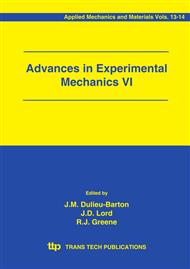p.183
p.195
p.203
p.213
p.225
p.233
p.239
p.247
p.251
Factors Influencing the Suitability of Thermal Methods for Stress Analysis of NiTi Shape Memory Alloys
Abstract:
The material assumptions made to facilitate Thermoelastic Stress Analysis (TSA) are linear elasticity, material homogeneity and isotropy, and mechanical properties that are independent of temperature. The unusual shape memory and superelastic properties of near equiatomic NiTi alloys complicate the application of any experimental stress analysis technique, and in the case of TSA, make these assumptions invalid. This paper describes a detailed analysis conducted to characterise the material properties of NiTi shape memory alloys and to identify loading conditions suitable for quantitative stress analysis using TSA. The mechanical behaviour of the material in three distinct regions is considered and the suitability of each region for TSA is discussed. It is shown that the thermoelastic response is dependent on the mean stress when tested at room temperature in the pre-martensitic phase, due the presence of an intermediate R-phase. Theoretical calculations are used to confirm that this effect is related to the high temperature dependence of the material’s Young’s modulus.
Info:
Periodical:
Pages:
225-230
Citation:
Online since:
July 2008
Permissions:
Share:
Citation:


